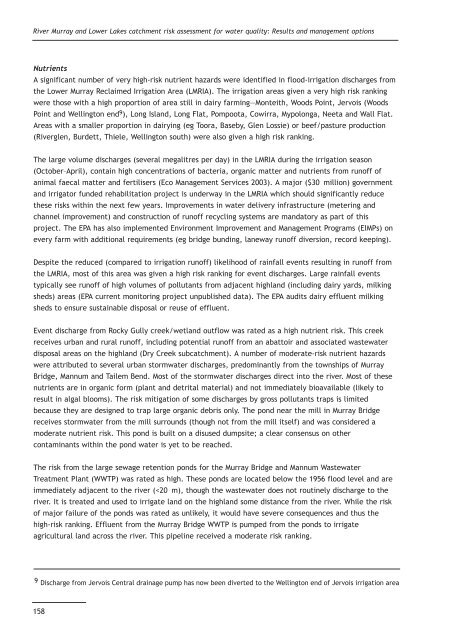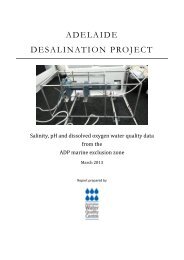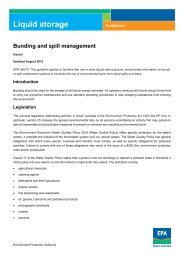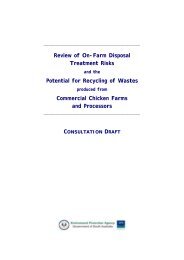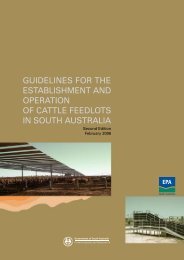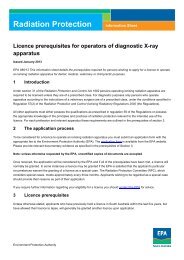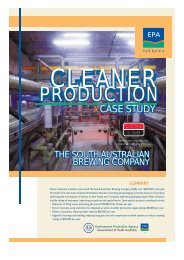2 Renmark to border LAP area assessment - EPA - Sa.gov.au
2 Renmark to border LAP area assessment - EPA - Sa.gov.au
2 Renmark to border LAP area assessment - EPA - Sa.gov.au
Create successful ePaper yourself
Turn your PDF publications into a flip-book with our unique Google optimized e-Paper software.
River Murray and Lower Lakes catchment risk <strong>assessment</strong> for water quality: Results and management options<br />
Nutrients<br />
A significant number of very high-risk nutrient hazards were identified in flood-irrigation discharges from<br />
the Lower Murray Reclaimed Irrigation Area (LMRIA). The irrigation <strong>area</strong>s given a very high risk ranking<br />
were those with a high proportion of <strong>area</strong> still in dairy farming—Monteith, Woods Point, Jervois (Woods<br />
Point and Welling<strong>to</strong>n end9 ), Long Island, Long Flat, Pompoota, Cowirra, Mypolonga, Neeta and Wall Flat.<br />
Areas with a smaller proportion in dairying (eg Toora, Baseby, Glen Lossie) or beef/pasture production<br />
(Riverglen, Burdett, Thiele, Welling<strong>to</strong>n south) were also given a high risk ranking.<br />
The large volume discharges (several megalitres per day) in the LMRIA during the irrigation season<br />
(Oc<strong>to</strong>ber–April), contain high concentrations of bacteria, organic matter and nutrients from runoff of<br />
animal faecal matter and fertilisers (Eco Management Services 2003). A major ($30 million) <strong>gov</strong>ernment<br />
and irriga<strong>to</strong>r funded rehabilitation project is underway in the LMRIA which should significantly reduce<br />
these risks within the next few years. Improvements in water delivery infrastructure (metering and<br />
channel improvement) and construction of runoff recycling systems are manda<strong>to</strong>ry as part of this<br />
project. The <strong>EPA</strong> has also implemented Environment Improvement and Management Programs (EIMPs) on<br />
every farm with additional requirements (eg bridge bunding, laneway runoff diversion, record keeping).<br />
Despite the reduced (compared <strong>to</strong> irrigation runoff) likelihood of rainfall events resulting in runoff from<br />
the LMRIA, most of this <strong>area</strong> was given a high risk ranking for event discharges. Large rainfall events<br />
typically see runoff of high volumes of pollutants from adjacent highland (including dairy yards, milking<br />
sheds) <strong>area</strong>s (<strong>EPA</strong> current moni<strong>to</strong>ring project unpublished data). The <strong>EPA</strong> <strong>au</strong>dits dairy effluent milking<br />
sheds <strong>to</strong> ensure sustainable disposal or reuse of effluent.<br />
Event discharge from Rocky Gully creek/wetland outflow was rated as a high nutrient risk. This creek<br />
receives urban and rural runoff, including potential runoff from an abat<strong>to</strong>ir and associated wastewater<br />
disposal <strong>area</strong>s on the highland (Dry Creek subcatchment). A number of moderate-risk nutrient hazards<br />
were attributed <strong>to</strong> several urban s<strong>to</strong>rmwater discharges, predominantly from the <strong>to</strong>wnships of Murray<br />
Bridge, Mannum and Tailem Bend. Most of the s<strong>to</strong>rmwater discharges direct in<strong>to</strong> the river. Most of these<br />
nutrients are in organic form (plant and detrital material) and not immediately bioavailable (likely <strong>to</strong><br />
result in algal blooms). The risk mitigation of some discharges by gross pollutants traps is limited<br />
bec<strong>au</strong>se they are designed <strong>to</strong> trap large organic debris only. The pond near the mill in Murray Bridge<br />
receives s<strong>to</strong>rmwater from the mill surrounds (though not from the mill itself) and was considered a<br />
moderate nutrient risk. This pond is built on a disused dumpsite; a clear consensus on other<br />
contaminants within the pond water is yet <strong>to</strong> be reached.<br />
The risk from the large sewage retention ponds for the Murray Bridge and Mannum Wastewater<br />
Treatment Plant (WWTP) was rated as high. These ponds are located below the 1956 flood level and are<br />
immediately adjacent <strong>to</strong> the river (


